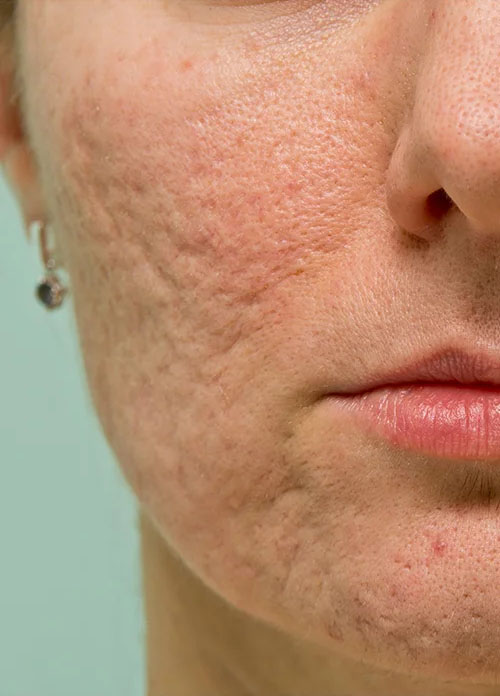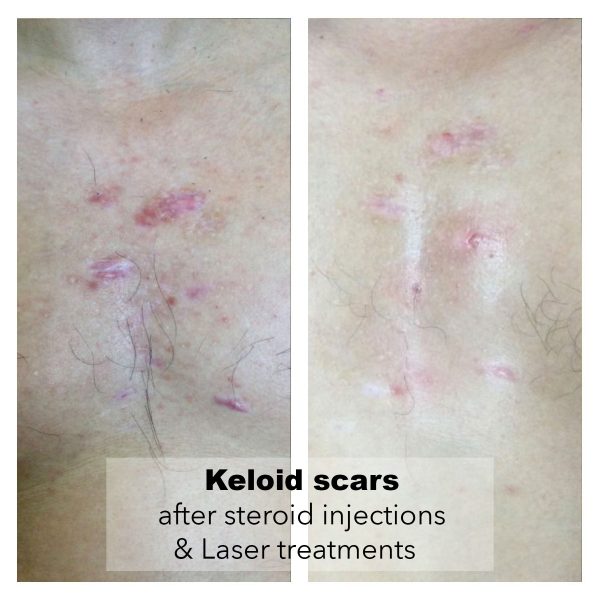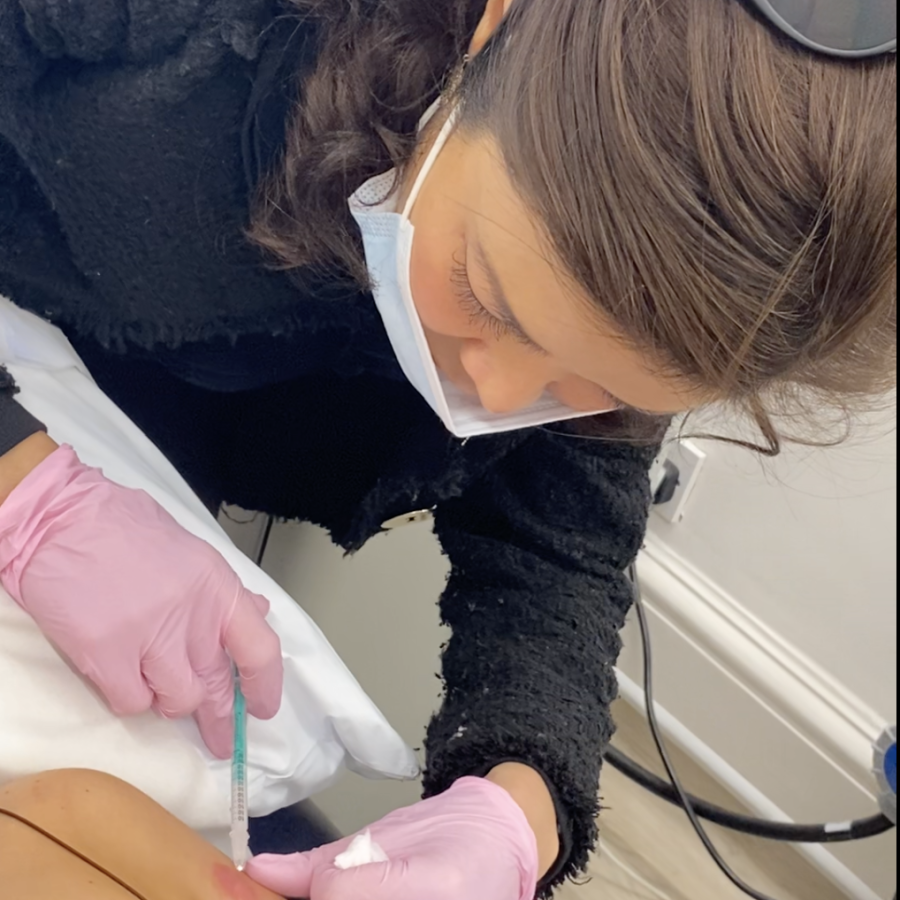SCARS
Scars, whether from injury, surgery, or acne, can be more than skin deep. They can impact our self-esteem and how we feel about our appearance.

Scar Treatments
Scars can vary widely and require tailored treatments, depending on your age and how long you’ve had the scar. It is essential to determine precisely what type of scar it is before selecting a treatment approach using an incorrect procedure might aggravate its look.
Scar Revision
Fortunately, modern medicine offers various scar treatment options to help you regain confidence and reveal your most beautiful self.

Treatment Options:
Several effective scar treatment options are available, including:
Topical Treatments: Over-the-counter or prescription creams and gels may help improve the appearance of scars, particularly when used early.
Micro-Needling: This minimally invasive procedure stimulates collagen production, which can help improve the texture and appearance of scars.
Laser Therapy: Laser treatments can target specific scar types, promoting collagen growth and minimizing their appearance.
Dermal Fillers: Used for atrophic scars, dermal fillers can lift and plump the scarred area for a smoother appearance.
Steroid Injections: For hypertrophic and keloid scars, injections can help flatten and soften their appearance.
Surgical Scar Revision: This involves removing the old scar and creating a new, less noticeable one.

Over 20 years of Skincare
Our dermatology clinic cares for common and rare skin, hair, nails and mucous membranes problems. Some common skin conditions we treat include acne, rosacea, eczema, psoriasis, skin cancer, and infections.
We also specialise in aesthetic dermatology, which includes cosmetic procedures to improve the appearance of the skin, such as chemical peels, laser therapy, Botox and filler injections.
Our mission is to help our patients have healthy skin and feel comfortable in their own skin. Taking care of our skin can help prevent many skin problems and keep skin healthy and glowing.
See what our patients say
“Dr Miller is the best doctor of any kind I’ve ever had and I would highly recommend her. She has provided me with a number of treatments at a different clinic, but each with tremendous care, kindness and expertise. Most notably, she has made my keloid acne chest scars barely visible now in size and colour. I really can’t thank her enough for making me feel confident about my body again.”
Daniel Sek 
“Dr Miller is always super clear on what is happening during my appointments, friendly and professional experience which helps put your mind at rest. Thorough explanation on course of action and provided a realistic response as to what the end result will be. I am also really happy with the results so far! The clinic was easy to find, centrally located nearby Sloane Sq tube."
Selena Brown
“Fabulous experience with Dr. Miller. She listens and works with you to understand the look you want to achieve. The filler treatments I have had look great, very natural and were almost pain-free with minimal downtime. I highly recommend Dr Miller to anyone looking for a skincare specialist."
Lindsay Johnson 
FAQ
There are several different types of scars, including:
Colour changed: After skin inflammation subsides, post-inflammatory colour change of the area may be observed. Although they will improve over time, it could take several months to vanish completely.
- Red, pink or purple marks: Post-inflammatory erythema (PIE) is the aftermath of inflammation, leaving behind distinct red, pink or purple spots. Blood vessel dilation and damage due to the inflammatory process can lead to these discolourations on your skin that may take up to 6 months to vanish entirely.
- Brown, grey, or dark marks: Post-inflammatory hyperpigmentation (PIH)is a temporary pigmentary alteration caused by skin trauma or inflammation. Melanin overproduction leads to darkening of specific areas on the face and body. It is typically seen more often in those with darker complexions. PIH can occur alongside post-inflammatory erythema (PIE) yet may last longer than PIE does for some individuals.
- White marks: Post-inflammatory hypopigmentation is a characteristic loss of natural skin pigment after an injury to the area has healed. It results from destruction or damage incurred during the healing process on melanocyte cells, which are responsible for producing pigments in our skin. This condition is especially noticeable and more obvious in people with darker complexions but can occur on any skin phototype.
Texture changed:
- Normal fine-line scars: Minor wounds such as cuts will often heal to form a raised line that gradually flattens and fades out over two years. Unfortunately, the scar will not completely disappear, leaving a visible mark or line. Fine-line scars are common after a wound or surgery. Though typically not painful, some might feel itchy for months afterwards.
- Pitted or sunken scars: otherwise known as Atrophic scars, are caused by the skin’s inability to regenerate new tissue. These types of scars generally form after certain skin conditions like acne and chickenpox but can also be developed due to an injury that leads to fat loss under the skin. These scars often leave an emotional scar in addition to a physical one.
Raised, thick and lumpy scars: Keloid scars and hypertrophic scars are both types of raised scars that form due to an overproduction of collagen during the healing process. However, they differ in their appearance, size, and location.
Keloid and hypertrophic scars are both raised scars that form due to an overproduction of collagen during the healing process. While they share some similarities, there are important differences between the two:
Keloid scars:
- Appearance: Keloid scars are thick, raised scars extending beyond the original wound’s boundaries. They are often shiny and have smooth surfaces.
- Size: Keloid scars can be quite large and can continue to grow over time. They may also be challenging to treat due to their size.
- Location: Keloid scars can occur anywhere on the body, but they are more common in areas where the skin is under tension, such as the chest, shoulders, earlobes, and along the jawlines. If you are predisposed to keloid scarring, it may appear in multiple locations.
- Risk factors: Keloid scars are more common in people with darker skin tones and tend to run in families.
Hypertrophic scars:
- Appearance: Hypertrophic scars are also thick, raised scars, but they do not extend beyond the boundaries of the original wound. They have a more flattened appearance compared to keloid scars.
- Size: Hypertrophic scars tend to be smaller than keloid scars, and they typically do not continue to grow over time.
- Location: Hypertrophic scars can occur anywhere on the body, but they are more common in areas where the skin is under tension, such as the chest, shoulders, and earlobes.
- Risk factors: Hypertrophic scars can occur in people of any skin tone and tend to occur more frequently in younger people.
Treatment options for both keloid and hypertrophic scars may include corticosteroid injections, laser therapy, silicone dressings, and surgery. It is important to work with a dermatologist to determine the best treatment plan for your specific case of raised scarring.
Unfortunately, Keloids are still incurable. Nevertheless, there are ways to help flatten them and reduce the associated discomfort. No one treatment method has been proven better; in fact, keloids often tend to recur after treatment. While there is no one-size-fits-all treatment for keloids, several options may be effective in reducing their size and appearance.
- Steroid Injections: Injections of corticosteroids, such as triamcinolone into the keloid can help flatten and shrink keloids. The injections are typically given every few weeks, and multiple treatments may be necessary. Side effects, steroids can make the skin thin, fragile and pale.
- Applying a strong steroid cream or steroid-containing tape.
- Silicone sheets or gels: can be placed over keloids to reduce their size and appearance. They work by hydrating the skin and creating a barrier that helps to reduce collagen production. This method is safe and can be effective if used for several months.
- Compression with bandages or devices (such as clips or splints) may sometimes help, particularly on the earlobe and for keloids on the torso.
- Surgery: Surgical removal of keloids is an option, but there is a risk that the keloid may recur or become even more extensive. To reduce the risk of recurrence, surgeons may use corticosteroid injections or radiation therapy in conjunction with the surgery.
- Radiotherapy can be used after the surgical removal of keloids to reduce the risk of recurrence. It can also be used as a standalone treatment to shrink keloids. However, it has a small risk of causing skin cancer due to radiation exposure. Therefore, this treatment is rarely prescribed.
- Cryotherapy involves freezing the keloid with liquid nitrogen, which can help to reduce its size and flatten it. This method can effectively treat medical conditions, either on its own or in combination with other treatments. However, it is essential to note that cryotherapy may cause a temporary loss of skin pigmentation.
- Laser therapy can be used to reduce the size and redness of keloids. It works by targeting the blood vessels that supply the keloid with nutrients. This method is effective for maximum results, especially when paired with steroid injections.
- If you’re looking for something experimental, consider botulinum toxin injections, 5-fluorouracil (5-FU) or bleomycin injections, and photodynamic therapy. All of these procedures have the potential to make a difference in your health outcomes.
The time it takes for steroid injections to work on scars can vary depending on the individual and the severity of the scar. Steroid injections are commonly used to treat hypertrophic and keloid scars, as they can help to reduce inflammation and flatten the scar.
After the injection, you’ll feel a softening of the scar, and your discomforting symptoms, like pain and itching, will decrease several days afterwards. In some cases, patients may notice a reduction in the size and redness of the scar within a few days of the first injection. However, it typically takes several weeks to see significant improvement.
Patients may require multiple injections over several weeks or months to achieve the desired result. The frequency of the injections will depend on the severity of the scar and the individual’s response to treatment.
After multiple injections, the scars usually become less visible and flatten within three to six months. In instances with bigger or more resistant lesions, it might take longer for this process to occur. The full effect of the treatment may not be apparent for several months as the scar continues to heal and collagen production slows down.
It is important to work closely with a dermatologist or plastic surgeon who has experience treating scars to determine the best treatment plan for your individual case.
Though it is possible to experience a few mild side effects, these usually resolve over time. You could experience the following.
- Pain: The introduction of steroids to the scar can cause soreness, with discomfort lasting up to 48 hours. If needed, paracetamol is an effective and safe pain relief option.
- Bleeding: It is not uncommon to witness small bleeding after the injection. To prevent further complications, keep your adhesive plaster on until it ceases.
- Atrophy: The tissue around the scar contracts, causing an indentation in the skin. This phenomenon is known as shrinkage.
- Hyper/hypopigmentation: Steroid injections can sometimes cause changes to the skin’s pigmentation, causing either lightening (hypo) or darkening (hyper).
- Telangiectasia: Sometimes, small reddish spots known as purpura can become visible around the injection site. This is due to an enlargement of microscopic blood vessels in that area.
Schedule a free consultation
Copyrights © 2022 All Rights Reserved By Dr Natalie Miller.
